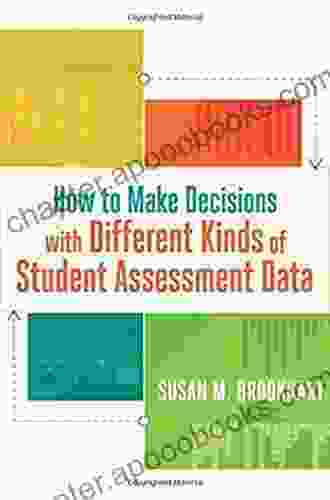Unlocking the Power of Student Assessment Data: A Comprehensive Guide for Data-Driven Decision-Making


In today's data-driven educational landscape, student assessment data has become an invaluable asset for educators and administrators seeking to improve student learning outcomes. However, effectively utilizing this wealth of information requires a deep understanding of the different types of assessment data available and how to interpret and apply it to inform decision-making.
4.3 out of 5
| Language | : | English |
| File size | : | 2174 KB |
| Text-to-Speech | : | Enabled |
| Screen Reader | : | Supported |
| Enhanced typesetting | : | Enabled |
| Word Wise | : | Enabled |
| Print length | : | 146 pages |
This comprehensive article will serve as a guide for educators and administrators seeking to harness the power of student assessment data. We will explore the different types of assessment data, discuss best practices for data analysis, and provide practical strategies for using data to drive instructional decisions and improve student achievement.
Types of Student Assessment Data
Student assessment data can be broadly categorized into two main types: formative and summative.
Formative Assessment Data:
* Collected throughout the learning process * Provides ongoing feedback on student progress * Informs instructional decisions and adjustments * Examples: quizzes, homework assignments, class discussions
Summative Assessment Data:
* Administered at the end of a unit or course * Measures student achievement against established standards * Used for grading and reporting purposes * Examples: unit tests, final exams, standardized tests
Data Analysis Best Practices
To derive meaningful insights from student assessment data, it is essential to follow sound data analysis practices:
* Disaggregate Data: Break down data by student subgroups (e.g., grade level, ethnicity, English learner status) to identify areas of strength and need. * Analyze Trends: Track data over time to identify patterns and trends in student performance. * Use Multiple Measures: Triangulate data from different sources (e.g., formative assessments, summative assessments, student surveys) to gain a comprehensive view of student understanding. * Interpret Data Contextually: Consider factors such as student demographics, socioeconomic status, and classroom environment when interpreting data.
Using Data to Drive Instructional Decisions
Once assessment data has been analyzed, it can be used to inform a wide range of instructional decisions:
* Identify Struggling Students: Data can pinpoint students who are struggling in specific areas, enabling educators to provide targeted support. * Adjust Instruction: Data can guide adjustments to teaching strategies, curriculum, and pacing to better meet the needs of students. * Set Realistic Goals: Data can help educators establish realistic goals for student achievement based on their strengths and areas for growth. * Monitor Progress: Data can track student progress over time and identify areas where additional support or intervention is needed. * Evaluate Programs and Curricula: Data can be used to evaluate the effectiveness of instructional programs and curricula and make data-informed decisions about their continued use.
Strategies for Using Data Effectively
To maximize the impact of data-driven decision-making, educators and administrators should employ the following strategies:
* Establish a Culture of Data Use: Create a school or district culture that values and uses data to improve instruction. * Build Data Literacy: Provide training and support for educators to develop their data analysis and interpretation skills. * Collaborate with Data Teams: Foster collaboration among teachers, administrators, and other stakeholders to analyze data and make informed decisions. * Use Technology: Utilize data management systems and visualization tools to facilitate data analysis and decision-making. * Engage Students in Data Analysis: Involve students in the process of collecting, analyzing, and interpreting data to foster their self-assessment skills.
Benefits of Data-Driven Decision-Making
By effectively using student assessment data, schools and districts can reap numerous benefits:
* Improved Student Learning: Data-driven decision-making leads to more targeted and effective instruction, resulting in improved student achievement. * Reduced Achievement Gaps: Data analysis can help educators identify and address disparities in student performance, reducing achievement gaps. * Increased Teacher Effectiveness: Access to real-time data empowers teachers to make informed decisions about their instruction and improve their practice. * Accountability and Transparency: Data-driven decision-making promotes accountability and transparency by providing evidence of student progress and the impact of instructional practices. * Informed Resource Allocation: Data can guide resource allocation decisions to ensure that schools and districts are providing the necessary support to students and educators.
Student assessment data is a powerful tool that can revolutionize educational decision-making. By understanding the different types of assessment data, applying sound data analysis practices, and employing effective strategies for using data, educators and administrators can harness this wealth of information to improve instruction, monitor progress, and ultimately ensure the success of all students.
Unlock the power of student assessment data today and embark on the path to creating a data-driven educational environment where every student thrives.
4.3 out of 5
| Language | : | English |
| File size | : | 2174 KB |
| Text-to-Speech | : | Enabled |
| Screen Reader | : | Supported |
| Enhanced typesetting | : | Enabled |
| Word Wise | : | Enabled |
| Print length | : | 146 pages |
Do you want to contribute by writing guest posts on this blog?
Please contact us and send us a resume of previous articles that you have written.
 Book
Book Novel
Novel Page
Page Chapter
Chapter Text
Text Story
Story Genre
Genre Reader
Reader Library
Library Paperback
Paperback E-book
E-book Magazine
Magazine Newspaper
Newspaper Paragraph
Paragraph Sentence
Sentence Bookmark
Bookmark Shelf
Shelf Glossary
Glossary Bibliography
Bibliography Foreword
Foreword Preface
Preface Synopsis
Synopsis Annotation
Annotation Footnote
Footnote Manuscript
Manuscript Scroll
Scroll Codex
Codex Tome
Tome Bestseller
Bestseller Classics
Classics Library card
Library card Narrative
Narrative Biography
Biography Autobiography
Autobiography Memoir
Memoir Reference
Reference Encyclopedia
Encyclopedia Linda Evans Shepherd
Linda Evans Shepherd Lynn Koolish
Lynn Koolish Philip G Joyce
Philip G Joyce Marianne Jones
Marianne Jones Marion Nash
Marion Nash Orin Starn
Orin Starn Lawrence Byng
Lawrence Byng Mangey Ram
Mangey Ram Pippa Dacosta
Pippa Dacosta Lili Valente
Lili Valente Lucky Moon
Lucky Moon Lionel Smith
Lionel Smith Lucy Middlemass
Lucy Middlemass Vered Sion
Vered Sion Lorand Gaspar
Lorand Gaspar Lee Drutman
Lee Drutman Michael Fisher
Michael Fisher Stephen Kantrowitz
Stephen Kantrowitz Liz Williams
Liz Williams Lesley Bartlett
Lesley Bartlett
Light bulbAdvertise smarter! Our strategic ad space ensures maximum exposure. Reserve your spot today!
 Mason PowellFollow ·12.2k
Mason PowellFollow ·12.2k Dennis HayesFollow ·7.2k
Dennis HayesFollow ·7.2k Rex HayesFollow ·5k
Rex HayesFollow ·5k Percy Bysshe ShelleyFollow ·13.7k
Percy Bysshe ShelleyFollow ·13.7k James JoyceFollow ·13.1k
James JoyceFollow ·13.1k Manuel ButlerFollow ·8.7k
Manuel ButlerFollow ·8.7k Jan MitchellFollow ·11k
Jan MitchellFollow ·11k Mark MitchellFollow ·17.6k
Mark MitchellFollow ·17.6k

 W.H. Auden
W.H. AudenTerrorist Events Worldwide 2024: A Comprehensive Guide to...
Terrorism is a global threat that affects...

 Carson Blair
Carson BlairBeautifully Uplifting And Enchanting Novel Set In The...
Set in the beautiful West Country, this...

 Jeffrey Cox
Jeffrey CoxAn Utterly Captivating and Uplifting Story of One Woman's...
Immerse yourself in an extraordinary...

 Greg Foster
Greg FosterEngaging the Issues Through the Politics of Compassion
: The Power of...
4.3 out of 5
| Language | : | English |
| File size | : | 2174 KB |
| Text-to-Speech | : | Enabled |
| Screen Reader | : | Supported |
| Enhanced typesetting | : | Enabled |
| Word Wise | : | Enabled |
| Print length | : | 146 pages |
















